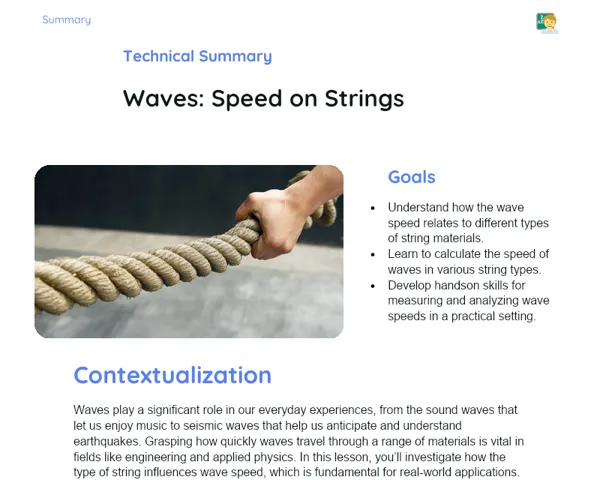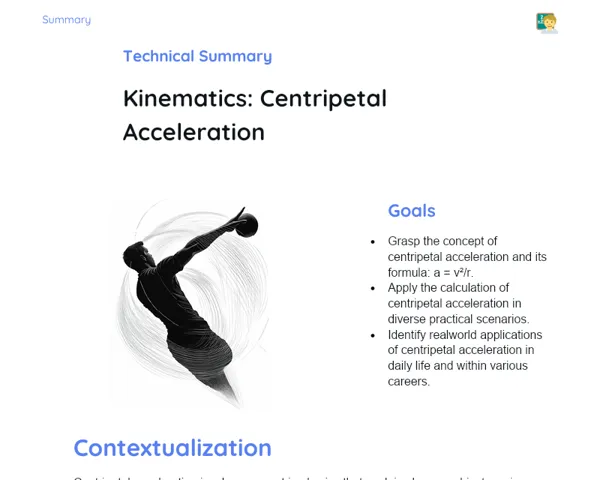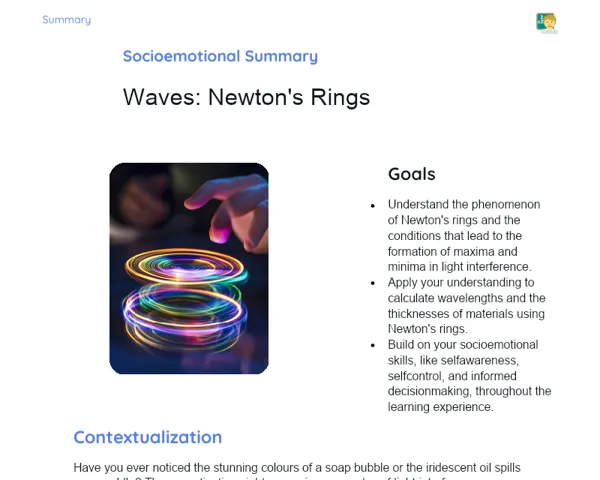Socioemotional Summary Conclusion
Goals
1. Get to grips with what inertia is and how it links to Newton's 1st Law.
2. Understand that an object at rest or moving in a straight line at a constant speed has zero acceleration, implying that all acting forces sum up to zero.
Contextualization
Think about being on a taxi when it comes to a sudden halt. Why do you feel like you're being thrown forward? 🤔 It's all about inertia – a key principle in physics that can also help us navigate our emotions and maintain our zen during times of change. Let's explore together how Newton's 1st Law plays out in our everyday lives! 🚀
Exercising Your Knowledge
Principle of Inertia
Newton's 1st Law, known as the Law of Inertia, tells us that an object at rest remains at rest, and an object in motion keeps on moving at a steady pace unless a force acts upon it. This concept helps us grasp how forces influence the movement of objects and is crucial in the realm of physics.
-
Inertia is the tendency of an object to resist any change in its motion.
-
An object at rest won’t move unless a strong external force is applied.
-
An object in motion will only stop or change its direction if an external force interferes.
-
You can see this principle in action in everyday life, like when a car suddenly brakes and passengers lurch forward.
Zero Net Force
Zero net force occurs when all the forces acting on an object balance each other out, resulting in a total force of zero. In this state, the object's motion doesn’t change: if it’s stationary, it’ll stay that way; if it’s moving, it continues straight and steady. This is vital for understanding the equilibrium and stability of physical systems.
-
Zero net force means that all forces cancel each other out, resulting in no overall force.
-
When the net force is zero, an object at rest will stay at rest.
-
If there’s no net force acting on a moving object, it will keep its steady speed.
-
This condition explains why an object can seem motionless or move at a constant speed without speeding up or slowing down.
Coin and Card Experiment
This hands-on experiment illustrates the principle of inertia using simple materials: a cup, a card, and a coin. By quickly yanking the card, the coin plops into the cup due to inertia. This fun experiment vividly shows Newton's 1st Law in action.
-
Set up by placing a card over the cup's opening with a coin on top.
-
When the card is pulled swiftly, the coin resists moving and stays in place because of inertia.
-
As the card is pulled away, the coin has nothing supporting it and drops into the cup.
-
This experiment is an engaging way to see how inertia functions practically.
Key Terms
-
Newton's 1st Law: Also known as the Law of Inertia, stating that an object at rest or moving uniformly in a straight line will stay that way unless acted upon by an external force.
-
Inertia: The property of an object to resist changes in its state of motion.
-
Net Force: The total of all forces acting on an object.
-
Uniform Straight-Line Motion: Motion along a straight path at a constant speed, indicating zero acceleration.
-
Equilibrium: A condition where the net force on an object is zero, keeping its motion unchanged.
For Reflection
-
How can understanding inertia help you maintain your cool during stressful or uncertain times?
-
How does the concept of zero net force clarify when it’s time for you to step in and change a situation?
-
Think back to a recent challenge you faced. How did your feelings shape your actions, and how could you have used strategies to manage your emotions more effectively?
Important Conclusions
-
Newton's 1st Law, or the Law of Inertia, teaches us that a body tends to keep its motion as it is, whether it’s stationary or moving steadily, unless an external force intervenes.
-
Grasping inertia is fundamental to understanding how objects interplay and move around us in everyday life.
-
The concept of zero net force is key for understanding how physical systems can remain balanced, keeping their motion constant.
Impacts on Society
In our daily lives, grasping Newton's 1st Law can be observed in numerous scenarios, such as road safety. For instance, the use of seatbelts is grounded in the principle of inertia: it keeps us safely in our seats during a sudden stop, preventing us from being flung forward. Understanding this concept helps us make safer and better-informed choices in our routines.
Also, we can relate inertia to our emotions. Just like an object resists changes in its movement, we often resist emotional shifts. Recognising this resistance can help us manage our feelings more effectively and act with more balance in emotionally charged situations, whether it's at school, home, or other social settings.
Dealing with Emotions
To better manage your emotions while exploring Newton's 1st Law, give the RULER method a go. First, Recognise your feelings: What emotions popped up while learning? Curiosity, frustration, excitement? Understand why you felt that way. Was it the complexity of the topic or the joy of discovering something new? Label those feelings accurately. Express them suitably, whether by chatting with friends or jotting down thoughts in a journal. Finally, Regulate your emotions: try breathing exercises or mindfulness to calm down and focus. Practice this during your studies and see how it can enhance your performance and well-being.
Study Tips
-
Create summaries and mind maps of Newton's 1st Law concepts. Visualising information in various ways can enhance retention.
-
Practice applying the concepts in real life, like watching how cars or objects move at home, and try explaining these phenomena through the lens of inertia.
-
Form study groups for group discussions and experiments! Collaborative learning often leads to fresh insights and makes studying much more enjoyable.



